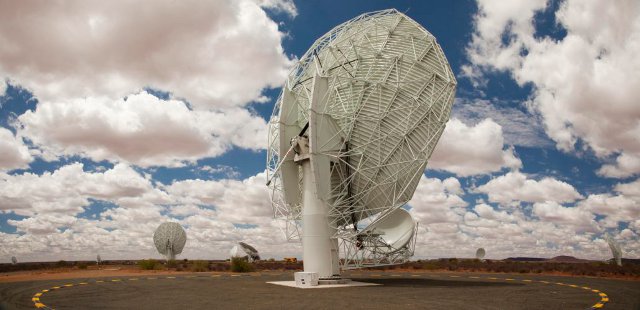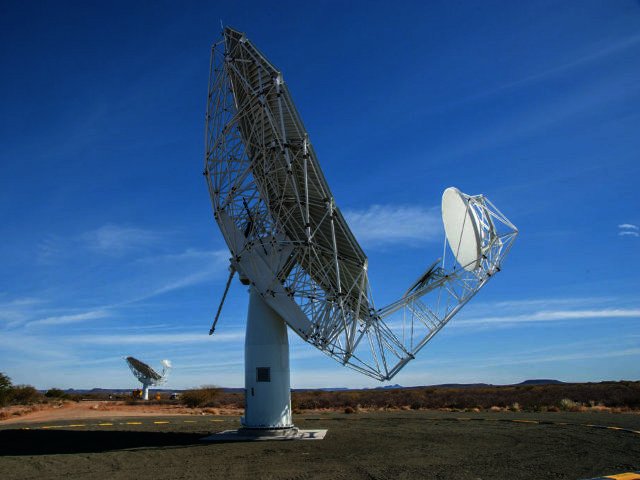The biggest science project Africa has ever seen begins with the assembly of a tiny node of steel. Intricately bound together, it weighs about as much as a light dumbbell, and is the basis of the back-up structure to the most advanced dish antenna system the continent has ever seen.
These back-up structures form the building blocks of the Square Kilometre Array (SKA), a battalion of enormous dish antennas being installed near Carnarvon, in the Northern Cape Province of South Africa. The entire array will eventually represent one million square metres of radio frequency collecting area and will capture data from outer space alongside eight other sites across Africa - and Western Australia too.
Collectively, these dish antennas will make up the largest telescope ever to probe into outer space: the Square Kilometre Array. Upon completion in 2032, the project will stand as the biggest scientific endeavour in the world - capable of detecting airport radar on a planet tens of light years away. Together, the dish antennas dotted around the globe will deliver images of space that outstrip the Hubble Telescope by a factor or 50.
The project was established in December 2011 with eleven member countries: Australia, Canada, China, Germany, India, Italy, New Zealand, South Africa, Sweden, the Netherlands and the UK. Unofficial members have also lent their expertise to the project, and it is estimated that over 100 organisations from 20 nations have been involved in the project at some stage. This is a truly global effort. Designs for the dish antennas hail from Germany, while American firm General Dynamics has been contracted to execute the project.
The first dish antennas have been manufactured in South Africa under the moniker MeerKAT, and 16 have been erected to date. MeerKAT is a test case for the much larger SKA project and will comprise 64 dish antennas in total, the remainder to be constructed throughout 2016 and 2017.
The initial MeerKAT array took its first images on July 16th 2016. The snapshot produced astounding results: an image of space revealing 1, 300 galaxies in an area where only 70 were visible before. The images display a snapshot seeded with thousands of galaxies and supermassive black holes yet still only accounts for a mere 0.01 percent of the sky. When you consider the depths that MeerKAT is already reaching, the vastness of space is truly mind-blowing.

If the SKA project proves anything, it’s that our fascination with space is unquenchable.
Amazingly, the team helping to build these monocles into the great unknown is part of a South African engineering firm, Namaqua Engineering, situated in the small town of Vredendal, some 430 kilometres from the Carnarvon SKA site. Every day, founder Stokkies van Zyl and his team arrive at work at 6AM to change the world. Van Zyl has a touch of Elon Musk about him. He’s a man of slight build but indomitable character who wears his nickname like a badge of pride. Stokkies means sticks in Afrikaans. But Van Zyl is made of iron.
Stokkies van Zyl and his team have been at work on the project since September 2015 and have been given a quota of 32 dish antenna back-up structures to manufacture for the MeerKAT project. By phase two, they’ll need to have produced 196, and by phase 3, with SKA well underway, 2500. Stokkies is pragmatic. “By that stage, I’ll need another 1000 employees.” Is it achievable? “Of course!” he says with a knowing smile. It seems the wheels of progress are already turning.
Most entrepreneurs would be daunted by this expansion, but to Van Zyl, no obstacle is too big. As one of his employees says, “Stokkies will challenge you and push you. You’ll think it’s impossible, but once you get there, you’ll look back and realize it was possible all along.” His desire for a challenge is one of the reasons he has transformed his business into the biggest employer in the Matzikama region and a provider of jobs for hundreds of families.
51 members of Van Zyl’s 162 staff work on the project full time. Machines cut and robots whir, while welders weld by hand. Everywhere you look sparks are flying. It is a veritable beehive of activity as structures and nodes are produced, one after the other. Every team member is entrusted with the duty to ensure that the next person down the line meets his deadline. Time is precious, and no one idles.
Namaqua Engineering currently has the capacity to produce two completed MeerKAT back-up structures per month. It will eventually be necessary to double this output. However, with painstaking attention to detail and high quality standards required for the project, it’ll take time, but Van Zyl is more than convinced that it is possible. Every part of the structure is carefully analysed and verified, and once assembled, the entire structure is put through a rigorous verification procedure to ensure that it conforms to the original design.
Five years ago, MeerKAT wouldn’t have been possible for Namaqua Engineering, since its skilled artisans still worked mostly by hand. But today, because of his vision and unbreakable will, Van Zyl has invested millions into the latest 2D and 3D laser cutter technology, robotic welding systems, physical verification instrumentation, software and accurate line boring equipment.
The SKA project is committed to finding life in space, and with Namaqua Engineering at the reins, that reality is closer than we think.
This month's business articles sponsored by:






